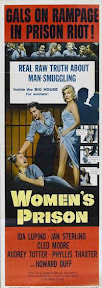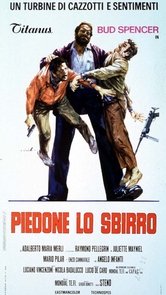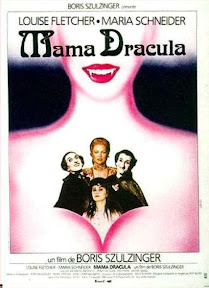 M
My friend Wendigo is a vampire movie fan, but he has a problem with vampire comedies. It's not that he objects to mockery of supernatural creatures, but as he sees it most vampire comedies go for the oldest, most obvious gags, the kind that seem meant to make you groan rather than laugh. You know, "pain in the neck" gags and stuff along those lines instead of genuinely funny characters and situations. One of the most recent attempts,
The Vampire's Assistant, is actually one of the more successful in Wendigo's eyes because its unique mythos required the writers to be creative in mining humor from the story instead of using the standard vampire gags. He liked
Love at First Bite as a kid but likes it less now. He tends to prefer comedies in which vampires happen to appear but are treated as more-or-less straight menaces, as in
The Monster Squad or
Vampire in Brooklyn. So when I told him I had an obscure European vampire comedy from a Mill Creek Entertainment box set, he approached
Mama Dracula with some trepidation -- and he was right to do so.
Boris Szulzinger's film is a deservedly obscure oddity that illustrates the rapidly shifting fortunes people can suffer in the movie racket. It features not one, but two performers from iconic Seventies films.
Louise Fletcher, taking the title role, was just five years removed from her Oscar-winning portrayal of Nurse Ratched in
One Flew Over the Cuckoo's Nest, while
Maria Schneider had
Last Tango in Paris and Michelangelo Antonioni's
The Passenger on her resume. Were they lured with big bucks after others steered clear, or were they already forced to be less choosy about their work? They would certainly have to be after this project, which could have been an understandable career killer for anyone involved.
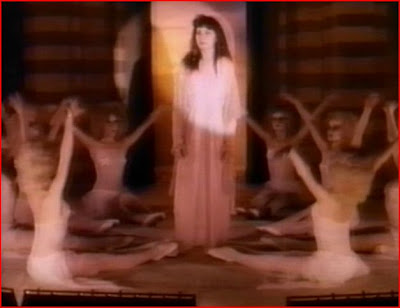
Above, Maria Schneider receives an undeserved tribute from the Mama Dracula Dancers. Below, Louise Fletcher tries to think happy thoughts.
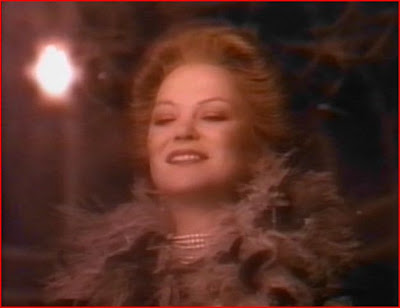
Mama Dracula is none other than our old friend
Erzsebet Bathory under a more marketable name. She may be Countess Dracula (not that that causes anyone alarm outside of a small Transylvanian suburb) but she lives in Castle Bathory, is named Erzebet, bathes in the blood of virgins and was once bricked inside the walls of her castle centuries ago. As she explains, the place was riddled with secret passages so it was easy to escape. Since then, she's been practicing the same hygenic regimen that has kept her looking like a big-boned American woman in her forties. But times are getting tougher. "In zis decadent modern vurld of ours," she asks in her charming accent, "vere can vun find wirgins?"
In her desperation she turns to modern science, summoning the allegedly eminent Dr. Peter Van Bloed to Transylvania for a "Blood Congress." It's a congress of one, as the egotistical little nebbish (he fantasizes out loud about getting the Nobel) finds himself the sole guest of the Countess and her eccentric twin sons, Vladimar and Ladislaus. While their mother aspires to elegance, and would never dare bare fangs (though she does offer to "bare you my secrets"), her boys -- wherever they came from -- oh, where to begin?
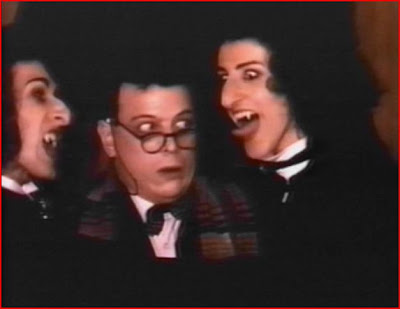
Jimmy Shuman, dressed like a lower-caste Time Lord, flanked by the incredible Wajnberg Brothers.
If you've ever tried to watch the Ritz Brothers in movies from the 1930s and 1940s, you might have an idea of our problem with Marc-Henri and Alexander Wajnberg. While the Marx Brothers and the Howard brothers crafted distinctive individual personalities for themselves, the Ritzes tried to be a sort of zany collective that forced you to laugh by sheer strength of numbers. You had three guys you couldn't really tell apart all yelling, laughing, pulling faces, etc. at the same time. There are only two Wajnbergs, but they're just as bad -- and English isn't their first language. Wendigo gives them credit for trying, but he assumes that they were cast for their goofy looks. They look like funhouse mirror versions of Frank Langella's Dracula and wear the full vampire regalia when they're not working their day jobs at the Vamp dress shop in the nearby big city. They seem to have been given little direction except to be funny, and they may not have understood the direction.
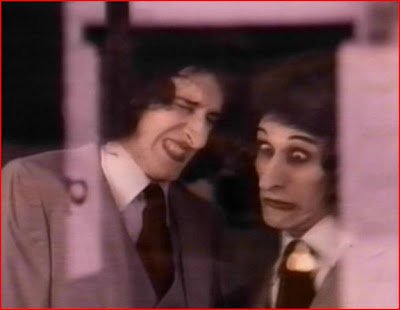
They do get one elaborately -- let's say
ponderously constructed gag that depends on the film's odd rules for vampires. The Countess and her boys are daywalkers who are unharmed by garlic or crosses -- though one of the brothers is repelled by a Star of David stitched on the rear of a teenager's panties. They bow to tradition in one respect: they cast no reflection in mirrors. This is all meant to set up a gag the next morning, when they get out of bed and perform their ablutions (including peeing into the sink) at back-to-back toilets designed as mirror images of each other. It looks like the "mirror" scene from Duck Soup, except the brothers are doing it on purpose: it dawns on you that they're acting as mirror images of each other for hygiene's sake. And just as the stupidity of that idea settles in, Dr. Bloed appears, sees one twin facing his own "reflection," sees none of himself, and draws a frightened conclusion. Here we should note that as a comedian, Jimmy Shuman as the doctor makes the Wajnbergs look like Laurel and Hardy. His is a role that requires the actor to either act scared often or keep up a steady barrage of wisecracks. Shuman does neither. He's simply presented to us as an egotistical nebbish who gets worried a few times but finally adopts the persona of a mad scientist. For example:
Our whole future lies in biosynthesis, in generic engineering. Imagine being able to transfer the genetic qualities of human hemoglobin to the e. coli chromosome by the plasmid method, and thus control the regulation of the genetic structure of cells!...But I'm never going to find the necessary genes in rabbit blood!
Dr. Bloed is introduced as if he's going to be the main character of the movie, just as Virginia the virginal but horny barmaid he encounters at a Transylvanian inn seems set up to be the film's romantic interest. Wrong on both counts. This film just keeps throwing new characters on top of the old ones, adopting the Hellzapoppin approach of trying everything in the hope that anything will work. Thus Maria Schneider is introduced as an assistant vampire hunter to a blustering inspector in a deerstalker. He assumes the Countess and her boys are innocent because he sees them in broad daylight. It's this defective detective, in fact, who finally deflowers Virginia, making her fair game for every other lout in the tavern until the whole building explodes. Transylvania, apparently, is where they put the bang in gangbang.
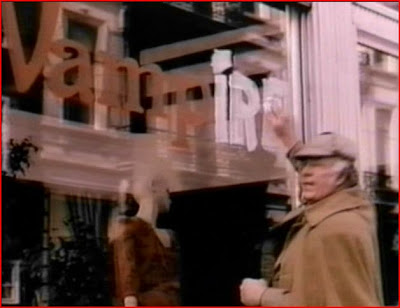
Maria continues the investigation but finds herself sabotaged by a punctured tire. The tire has fang marks in it. The fang marks bleed. It's that kind of movie. And it was at this point, Wendigo says, that it started to change from something insufferably inept to something compellingly bizarre. In his words, it had crossed a Rubicon. It had gotten so bad that it might become good. At the least, it would not be boring, but train wrecks rarely are.
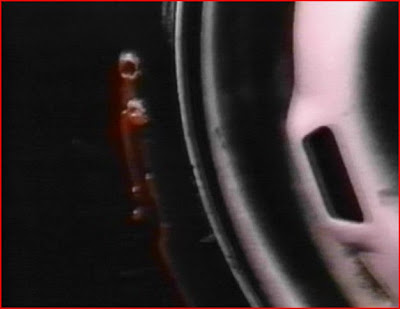
Szulzinger's pile-it-on approach nearly pays off in a climax that brings the entire cast together in the Countess's "cast-tell." Separate mobs of traditional torchbearing villagers and the city men whose fiances have been snatched from the Vamp boutique storm the castle (the city men arriving in a bus bearing a "Fiances Lib" sign. They storm right past a vampire and into ... a fashion show. It's the new line of ball gowns, allegedly inspired by classic movies. After heckling and throwing food at their vampire host (an audience identification moment if ever there was one), the angry crowd settles down to watch their women strut their stuff. This means a parade of ghastly-garbed proto-goths as one of the brothers recites film titles: "Death in Wenice...Ze Birds... Psycho... Some--Like--It--Hot!...Saturday Night Feewer...Apocalypse--Now...Chaws..."
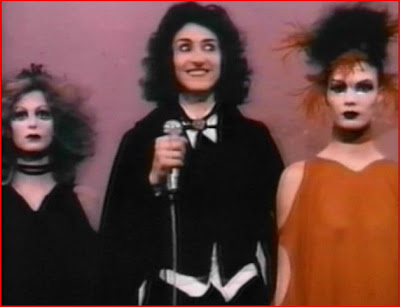
"Ze Birrds!"
And in the middle of this, Dr. Bloed and his questionably-gendered assistant Rosa burst in to announce the success of their great experiment. Until then, the incompetent scientist had only been able to make gold. But once Rosa suggested the formula "E=mc2," artificial blood became a reality with utopian promise for mankind. Let a vampire explain it to a mummy:
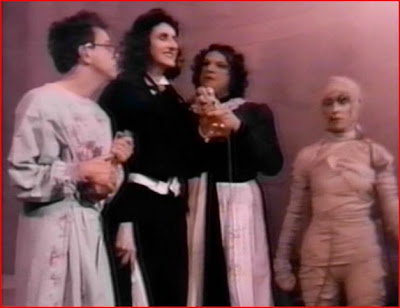
You, poor think! There is no need to be scared of dyink anymore. From now on, blood is awailable anytime, anyplace, buckets of it! Anyone who vants to be a wampire can be a wampire ven they would alike, vere they would alike, and vit who they would alike. Humanity can live in the lap of luxury. Eternity is vithin reach!
It's still not exactly funny, but it is almost charmingly insane, a rare moment of mad inspiration saved for last. But it's a hard slog to get there. Wendigo says that if he hadn't been watching it socially he might have given up on it early. So if you dare, watch it with a friend -- and hope he'll be your friend afterward.
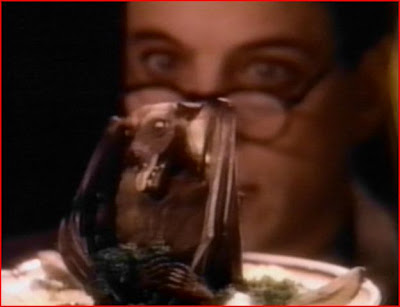
Mama Dracula might be enjoyed more thoroughly in a dinner-theater format with the right cuisine, but we have our doubts.
Wendigo sees the film as a complete mess, a mishmash of acting styles, Fletcher's overacting not exactly counterbalanced by Schneider's underacting -- or is it non-acting? He had a hard time wrapping his mind around the odd geography that requires the Draculas to commute through a primitive village to their modern shop in a thoroughly modern city -- a shop that is apparently directly linked to their castle by an underground tunnel. He was demoralized initially by how derivative the film was -- the wirgin-blood concept is stolen from
Andy Warhol's Dracula, and the brothers seem influenced by
The Rocky Horror Picture Show. Worse, at every moment the Mill Creek copy is a murky mess in its own right. But as the film snowballs downhill it develops a shape and momentum of its own. It eventually got one thing right: it ceased to be a mere vampire-movie parody and achieved its own uniquely idiotic inspiration. It ended up being not quite one of Wendigo's favorite vampire comedies, but one of the damnedest movies he's ever seen. He recommends it to bad-movie buffs only, whether they're vampire fans or not.
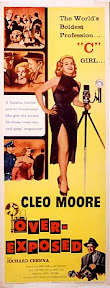 Cleo Moore quit movies early and has been largely forgotten by now, but she was kind of a big deal in her heyday. She worked hard for someone who never really broke into A pictures. While I was searching for newspaper ad art for Lewis Seiler's Over-Exposed I learned that she promoted the picture with an extensive personal-appearance tour. As a further publicity stunt, she announced a plan to run for governor of Louisiana, having once been married to a son of Huey Long. The year before, when Women's Prison came out, some territories promoted it as a Cleo Moore movie because she was going to be appearing with it, or had been in town recently enough to be a bigger draw for locals than Ida Lupino. As the box copy for Bad Girls of Film Noir Vol. 2 says, "Moore was often the 'bait' in movie publicity campaigns." You can see that in the Women's Prison poster art, which features her more prominently than her role warrants. Over-Exposed, meanwhile, is her own star vehicle. For all I know, it was the biggest showcase she ever got from Hollywood.
Cleo Moore quit movies early and has been largely forgotten by now, but she was kind of a big deal in her heyday. She worked hard for someone who never really broke into A pictures. While I was searching for newspaper ad art for Lewis Seiler's Over-Exposed I learned that she promoted the picture with an extensive personal-appearance tour. As a further publicity stunt, she announced a plan to run for governor of Louisiana, having once been married to a son of Huey Long. The year before, when Women's Prison came out, some territories promoted it as a Cleo Moore movie because she was going to be appearing with it, or had been in town recently enough to be a bigger draw for locals than Ida Lupino. As the box copy for Bad Girls of Film Noir Vol. 2 says, "Moore was often the 'bait' in movie publicity campaigns." You can see that in the Women's Prison poster art, which features her more prominently than her role warrants. Over-Exposed, meanwhile, is her own star vehicle. For all I know, it was the biggest showcase she ever got from Hollywood.



